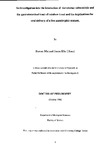An investigation into the interaction of Aeromonas salmonicida and the gastrointestinal tract of rainbow trout and the implications for oral delivery of a live auxotrophic mutant
| dc.contributor.author | Jones, Steven Michael | |
| dc.contributor.other | School of Biological and Marine Sciences | en_US |
| dc.date.accessioned | 2013-11-19T11:47:31Z | |
| dc.date.available | 2013-11-19T11:47:31Z | |
| dc.date.issued | 1996 | |
| dc.identifier | NOT AVAILABLE | en_US |
| dc.identifier.uri | http://hdl.handle.net/10026.1/2756 | |
| dc.description.abstract |
Furunculosis is a disease of great economic importance to the salmon fanning industry. The aetiological agent of the disease is Aeromonas salmonicida, probably the most studied pathogen of non mammalian hosts. Little information exists however on the most fundamental aspects of the infection process or the basis of acquired immunity. Although oral vaccination is an ideal solution to the problems of immunising fanned salmonids, poor immunogenicity has always limited the use of this route of administration. In mammals oral vaccination with live auxotrophic mutants has been shown to elicit both humoral and cellular immunity and provide protection against challenge. The recent development of an aroA mutant of A. salmonicida has enabled investigation into the response of rainbow trout to a live oral vaccine. Initially, the role of gastric acidity in the destruction of the live bacteria was investigated in vitro. Aeromonas salmonicida, Yersinia ruckeri and Escherichia coli were compared for acid resistance. Using a system of low pH buffers appropriate to the acidity found in the gut of rainbow trout it was found that A. salmonicida was readily killed by a pH of 4.0 or less. Resistance to low pH increased during stationary phase and 0.002% of bacteria grown for 72 hours were able to survive at least six hours exposure to pH 3.0, compared with 90% of Yersinia ruckeri exposed to the same conditions. The effect of culture medium, oxygen availability, and the pH of the culture medium were also investigated. Whilst growth in BHIB or in a shaking incubator did not alter the resistance of Aeromonas salmonicida to pH 3.0 growth in TSB adjusted to pH 5.5 increased survival of the bacteria by ten fold. It was apparent that the bacteria would probably require protection from the gastric acidity. The uptake and localisation of the bacteria was investigated by recovery and enumeration of viable bacteria from the stomach and intestinal mucus as well as the kidney, spleen and liver of fish vaccinated orally, anally and by IP injection. The presence of the bacteria was monitored between 5 minutes and 72 hours. Bacteria were found in the organs within 5 minutes of delivery regardless of route. The largest numbers were found following IP injection and the lowest following oral intubation. Oral administration of the vaccine protected by prior administration of sodium bicarbonate increased the number of bacteria found in the fish and increased the persistence within the tissues. The effect of growth conditions on the uptake and localisation was also investigated and no increase in uptake was found. Oral delivery of the bacteria in TSB increased the number of bacteria found within the organs to levels above that found following IP injection in TSB. Poor uptake has been reported for killed oral vaccines suggesting that the bacterium was able to invade the host via the gut mucosae. The interaction between trout intestine and A . salmonicida was investigated using TEM and SEM and the ability of the vaccine strain to invade cell monolayers was compared with that of an A-layer deficient strain and Y. rukeri. Infection of the trout intestine in vitro and in vivo led to pathological damage to the epithelium. There was also evidence of phagocyte infiltration and it was apparent that these cells were destroyed by contact with the bacteria. Invasion of tissue culture cells was assessed by acridine orange staining and enumeration of viable internalised bacteria. Aeromonas salmonicida appears to be invasive but its cytotoxic ECPs appear to kill most of the cells it enters. The specific and non-specific humoral immune response to vaccination was investigated. There was evidence of a limited effect on various nonspecific immune response parameters but there was no detectable antibody response to the vaccine. There is evidence that cellular immunity is preferentially stimulated by live vaccines and any future work should involve an investigation of the systemic and mucosal cellular response. | en_US |
| dc.language.iso | en | en_US |
| dc.publisher | University of Plymouth | en_US |
| dc.title | An investigation into the interaction of Aeromonas salmonicida and the gastrointestinal tract of rainbow trout and the implications for oral delivery of a live auxotrophic mutant | en_US |
| dc.type | Thesis | |
| plymouth.version | Full version | en_US |
| dc.identifier.doi | http://dx.doi.org/10.24382/4971 | |
| dc.identifier.doi | http://dx.doi.org/10.24382/4971 |
Files in this item
This item appears in the following Collection(s)
-
01 Research Theses Main Collection
Research Theses Main


